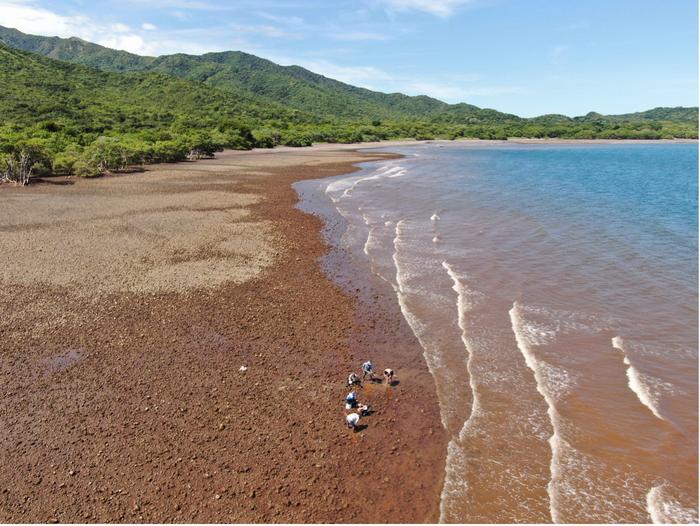Studying the impact of the environment on animal evolution is no easy task, as most animals reproduce slowly and exhibit complex behaviors. However, microbiologists have an advantage: Bacteria reproduce rapidly, which makes them a much easier subject for studying evolution.

Credit: Isidora Morel-Letelier / Max Planck Institute for Marine Microbiology
Studying the impact of the environment on animal evolution is no easy task, as most animals reproduce slowly and exhibit complex behaviors. However, microbiologists have an advantage: Bacteria reproduce rapidly, which makes them a much easier subject for studying evolution.
The Isthmus of Panama offers a natural experiment
Laetitia Wilkins and her team from the at the Max Planck Institute for Marine Microbiology in Bremen, Germany, studies bacterial evolution in a very unique scenario: the Isthmus of Panama. This landmass connects North and South America, thus separating the Pacific Ocean from the Caribbean Sea, and serves as an ideal location for observing “real-time evolution”. The closure of the Isthmus, which took place 2.8 million years ago, caused significant changes in the marine environments on both sides. The Caribbean side became warmer, more saline, and nutrient-poor, while the Tropical Eastern Pacific experiences variable temperatures, strong tides, and high nutrient levels. These environmental differences forced marine life to develop different survival strategies.
Lucinid clams and their symbiotic bacteria: Partners in evolution
Lucinids are marine bivalves that inhabit both the Caribbean and Pacific waters surrounding the Isthmus of Panama. At least 400 million years old, the family of lucinid clams inhabits a wide variety of habitats, from beautiful beaches to the dark abyssal depths. Their secret to success lies within: Symbiotic bacteria live inside their gills and help them meet their nutritional needs, forming such a close relationship that these clams couldn’t survive without their little companions.
Interestingly, the symbiotic bacteria don’t seem to depend on the lucinids. They can also live freely in the sediment. This allows them to interact with other bacteria and exchange genetic material with them, through what’s known as horizontal gene transfer. This, combined with their fast reproduction, helps them adapt rapidly to their environment.
“We wanted to find out how these symbiotic bacteria adapted to the different environmental conditions on both sides of the Isthmus”, says Isidora Morel-Letelier, who conducted the study as part of her doctoral thesis together with Benedict Yuen. To achieve this, the team traveled to Panama to collect lucinid clams and analyzed the DNA of the symbiotic bacteria in their gills to detect differences in their genomes.
Different adaptation in the Caribbean and the Pacific
Morel-Letelier discovered that symbiotic bacteria dealt with the challenge very differently on both sides of the Isthmus: Those in the Caribbean were able to fix nitrogen, whereas those in the Pacific lacked this ability. “Life is not possible without nitrogen. Because the Caribbean has very low levels of nitrate – an easily usable form of nitrogen –, the bacteria need other sources of this nutrient. Their ability to fix nitrogen likely allowed them to survive there. On the other hand, Pacific symbionts didn’t face this issue because their waters contain nitrate levels ten times higher than those in the Caribbean”, Morel-Letelier explains.
And there are more genetic differences. The scientists from Bremen discovered unique genes that were present in the Pacific symbionts, but were absent in the Caribbean ones. For example, symbionts in the Pacific had the potential to synthesize gammapolyglutamate, which is a storage compound produced by bacteria during nutrient limitation, or electron-transferring-flavoprotein (ETF) dehydrogenases, which are produced in response to low temperatures and anaerobic conditions. “These genes likely help the symbionts cope with the Pacific’s more significant seasonal changes in nutrients, temperature, and oxygen levels compared to the Caribbean”, says Morel-Letelier.
New metabolic capabilities revealed a unique evolutionary journey
The Max Planck scientists also wanted to understand how the Caribbean symbionts acquired the genes required for nitrogen fixation genes. For that, they compared the genomes of symbionts across the Isthmus of Panama with other lucinid symbiont genomes from around the world. “It seems like their last common ancestor did not possess the capacity for nitrogen fixation. Most probably nitrogen fixation is a recent trait acquired only by symbionts that faced a nutrient-poor environment”, explains Morel-Letelier. This finding highlights the critical role that the environment plays in shaping bacterial evolution. “Through horizontal gene transfer, lucinid symbionts likely obtained the nitrogen fixation genes from another symbiont lineage”, notes Morel-Letelier.
Future investigations should focus on understanding the symbiotic relationship between these bacteria and their lucinid hosts. “It would be very interesting to know whether the new metabolic capabilities of the bacteria, such as fixing nitrogen, benefit the lucinid clams in their ability to survive in the environment, and whether clams actively select the bacterial candidates that are better adapted to live inside them”, says Morel-Letelier.
“This study improves our understanding of the ability of bacteria to respond to environmental changes, which leads us to think that bacterial communities may already be adapting to anthropogenic changes, such as the flow of excess nutrients from agricultural fields into coastal waters,” group leader Laetitia Wilkins comments.
Journal
PLoS Genetics
Article Title
Adaptations to nitrogen availability drive ecological divergence of chemosynthetic symbionts
Article Publication Date
31-May-2024



